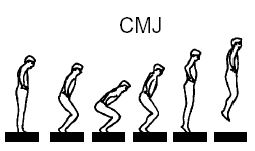Jump Height and Peak Velocity of a movement are very strongly correlated to one another. Peak velocity at the end of the push-off phase determines your jump height (Impulse – Momentum relationship). Technically speaking, you actually reach peak velocity right before you leave the ground, which means the highest peak velocity that occurs in a vertical jumping movement, say a jump squat, doesn’t actually occur at push off, instead right before. Because of this, technically speaking peak velocity will not give you a 100% accurate measure of vertical jump height. However, neither will a just jump mat or most any field testing tool that doesn’t directly calculate impulse. Which means in this case, reliability is very important and from my own personal work, using peak velocity is quite reliable (there are a couple of studies supporting me too).
Remember, peak velocity is going to be used a metric to determine an object’s displacement, in this case a jump height. One issue with peak velocity is that, well, it is peak velocity… As coach knowing peak velocity is cool, but kind of useless unless you have a calculator on hand during a training set… which I really hope you don’t. So, what good is peak velocity?
Well, peak velocity is great, especially for a nerd like myself. I like physics and I like numbers, which means I decided to put together a peak velocity “Cheat Sheet”.
Below is a graph of peak velocity (in this case representing push off velocity) and inches. Again, you can see that its kind of a mess and for the most part, useless in the weight room. However, it does give you quick snapshot of how jump height and peak velocity are not linearly related, which means you cannot just take peak velocity and assume an increase means one to one, linear increase in jump height. 
Continue reading “Using Tendo Units To Measure Jump Height (Physics Cheat Sheet)”














You must be logged in to post a comment.